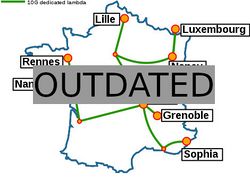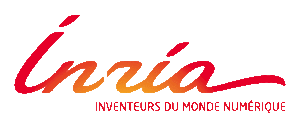Grid5000:Home: Difference between revisions
No edit summary |
No edit summary |
||
| Line 7: | Line 7: | ||
Key features: | Key features: | ||
* provides '''access to a large amount of resources''': 15000 cores, 800 compute-nodes grouped in homogeneous clusters, and featuring various technologies: GPU, SSD, NVMe, 10G and 25G Ethernet, Infiniband, Omni-Path | * provides '''access to a large amount of resources''': 15000 cores, 800 compute-nodes grouped in homogeneous clusters, and featuring various technologies: PMEM, GPU, SSD, NVMe, 10G and 25G Ethernet, Infiniband, Omni-Path | ||
* '''highly reconfigurable and controllable''': researchers can experiment with a fully customized software stack thanks to bare-metal deployment features, and can isolate their experiment at the networking layer | * '''highly reconfigurable and controllable''': researchers can experiment with a fully customized software stack thanks to bare-metal deployment features, and can isolate their experiment at the networking layer | ||
* '''advanced monitoring and measurement features for traces collection of networking and power consumption''', providing a deep understanding of experiments | * '''advanced monitoring and measurement features for traces collection of networking and power consumption''', providing a deep understanding of experiments | ||
Revision as of 00:57, 12 February 2020
|
Grid'5000 is a large-scale and flexible testbed for experiment-driven research in all areas of computer science, with a focus on parallel and distributed computing including Cloud, HPC and Big Data and AI. Key features:
Grid'5000 is merging with FIT to build the SILECS Infrastructure for Large-scale Experimental Computer Science. Read an Introduction to SILECS (April 2018)
Older documents:
|
Random pick of publications
Five random publications that benefited from Grid'5000 (at least 2517 overall):
- Ghada Moualla, Sébastien Bolle, Marc Douet, Eric Rutten. Self-adaptive Device Management for the IoT Using Constraint Solving. FedCSIS 2022 - 17th Conference on Computer Science and Intelligence System, Sep 2022, Sofia, Bulgaria. pp.1-10. hal-03770474 view on HAL pdf
- Reda Khoufache, Mustapha Lebbah, Hanene Azzag, Etienne Goffinet, Djamel Bouchaffra. Distributed Collapsed Gibbs Sampler for Dirichlet Process Mixture Models in Federated Learning. SIAM International Conference on Data Mining (SDM24), Apr 2024, Houston, Texas, United States. hal-04457596 view on HAL pdf
- Ajinkya Kulkarni, Vincent Colotte, Denis Jouvet. Analysis of expressivity transfer in non-autoregressive end-to-end multispeaker TTS systems. INTERSPEECH 2022, Sep 2022, Incheon, South Korea. hal-03832870 view on HAL pdf
- Romain Fontaine, Jilles Dibangoye, Christine Solnon. Exact and Anytime Approach for Solving the Time Dependent Traveling Salesman Problem with Time Windows. European Journal of Operational Research, In press, 10.1016/j.ejor.2023.06.001. hal-04125860v2 view on HAL pdf
- Marie Delavergne, Geo Johns Antony, Adrien Lebre. Cheops, a Service to Blow Away Cloud Applications to the Edge. ICSOC 2022 - 20th International Conference on Service-Oriented Computing, Nov 2022, Sevilla, Spain. pp.530-539, 10.1007/978-3-031-20984-0_37. hal-03926688 view on HAL pdf
Latest news
Failed to load RSS feed from https://www.grid5000.fr/mediawiki/index.php?title=News&action=feed&feed=atom: Error parsing XML for RSS
Grid'5000 sites
Current funding
As from June 2008, Inria is the main contributor to Grid'5000 funding.
INRIA |
CNRS |
UniversitiesUniversité Grenoble Alpes, Grenoble INP |
Regional councilsAquitaine |


